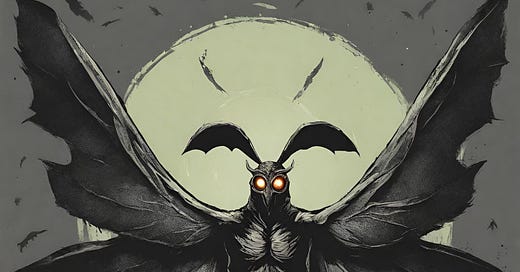The Mothman. A name that evokes images of a shadowy, winged figure with glowing red eyes, lurking in the darkness. This enigmatic creature has captured the imagination of paranormal enthusiasts for decades, its story intertwined with strange sightings, ominous warnings, and a tragic bridge collapse. But what is the truth behind the legend? Was the Mothman a harbinger of doom, a supernatural entity, or simply a product of misidentification and mass hysteria?
John Keel and the "Mothman Prophecies"
The Mothman's story gained widespread attention thanks to John Keel's 1975 book, "The Mothman Prophecies." Keel, a pioneer in paranormal research, investigated the strange occurrences surrounding the creature, connecting it to UFO sightings, Men in Black encounters, and other unexplained phenomena. His book, and the subsequent 2002 film adaptation starring Richard Gere, brought the Mothman to a global audience, sparking a fascination that continues to this day. Keel's unique approach, blending investigative journalism with a focus on the psychological and sociological aspects of belief, challenged conventional explanations and opened up new avenues for exploring the unknown. He even proposed his own theory, the "window theory", suggesting paranormal events are all connected and glimpses into something greater.
Winged Wonders: Precursors to the Mothman?
While the Point Pleasant sightings are the most well-known, reports of large, winged creatures predate the Mothman phenomenon. From the Owlman of Cornwall, a terrifying, owl-like humanoid sighted in the 1970s, to the "headless angel" seen by shepherdesses in Portugal in 1915, stories of winged figures have persisted for centuries. Even closer to home, the 1963 sightings in Kent, England, of a large, black, winged figure, sometimes associated with UFOs, share striking similarities with the Mothman narrative. These historical accounts raise questions about the nature of these sightings and whether they share a common origin.
The Terror of Point Pleasant: A Chronicle of Encounters
The Mothman's reign of terror in Point Pleasant, West Virginia, began in 1966. Numerous eyewitnesses, often in groups, reported seeing a large, man-like creature with leathery wings, glowing red eyes, and an imposing presence. These sightings often occurred near the "TNT Area," a former World War II ammunition plant, adding to the sense of mystery and unease.
One of the first reported encounters involved two young couples who, while driving near the TNT Area, encountered the Mothman standing by the roadside. They described it as a tall, winged figure with glowing red eyes that followed their car at high speed. Other sightings followed, with witnesses reporting similar descriptions and a feeling of dread associated with the creature's presence. Some even reported hearing a high-pitched squeak or a sound like a "giant mouse."
The sightings escalated throughout 1966 and 1967, with reports coming in from across West Virginia. Some witnesses described the Mothman as having a wingspan of up to ten feet and the ability to fly at incredible speeds. The consistency of these accounts, despite the witnesses being unrelated, lent credence to the idea that something truly extraordinary was happening.
Theories and Speculations: Unraveling the Mystery
What was the Mothman? Numerous theories have been proposed to explain the sightings. Some suggest misidentification of large birds, such as owls or cranes. Others point to mass hysteria, where initial sightings created a feedback loop, making people more likely to see and interpret ambiguous things as the Mothman. Psychological factors, such as stress and fear, could also have influenced witnesses' perceptions.
Of course, there are also the more "out there" theories, including supernatural or paranormal explanations. Some believe the Mothman was an interdimensional being, an ultraterrestrial, or even a demonic entity. While these theories lack scientific evidence, they remain popular among those who believe in the unexplained.
The Silver Bridge Collapse: A Tragedy and a Legend
The Mothman's story is inextricably linked to the tragic collapse of the Silver Bridge on December 15, 1967. The bridge, which connected Point Pleasant to Ohio, suddenly gave way during rush hour, sending cars and people plunging into the icy Ohio River. Forty-six lives were lost, and many bodies were never recovered.
The timing of the collapse, just over a year after the first Mothman sightings, fueled speculation that the creature was somehow connected to the tragedy. Some believed it was a harbinger of doom, warning of the impending disaster. Others suggested it was a malevolent entity that caused the collapse. While investigations revealed a structural flaw in the bridge as the actual cause, the legend of the Mothman's connection to the tragedy persists.
The Mothman Today: A Modern Myth
While the Point Pleasant sightings largely subsided after the bridge collapse, the Mothman legend has endured. In recent years, there have been sporadic reports of similar winged creatures in other locations, most notably Chicago. These modern sightings often share similar descriptions with the original Mothman, including glowing red eyes and a large wingspan. The persistence of these sightings raises questions about whether the Mothman is a real creature, a recurring paranormal phenomenon, or simply a modern myth that continues to evolve.
The Mystery Endures
The Mothman remains an enigma, a puzzle with no easy answers. Whether it was a misidentified bird, a supernatural entity, or a figment of collective imagination, the Mothman has left an indelible mark on popular culture. Its story serves as a reminder of the power of belief, the allure of the unknown, and the enduring human fascination with the strange and mysterious. As new sightings emerge and old theories are re-examined, the legend of the Mothman continues to intrigue and inspire, ensuring that this winged wonder will continue to haunt our imaginations for generations to come.
Check out our paid subscriber episode on the Mothman here



